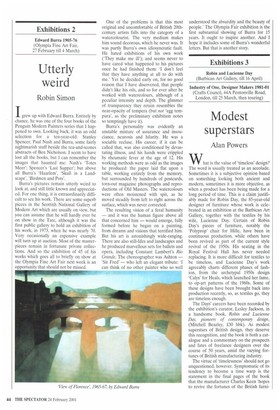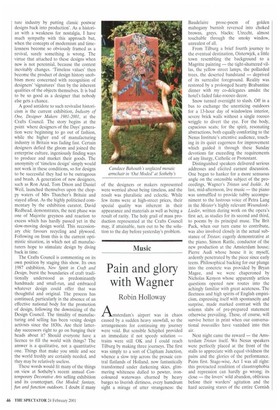Robin and Lucienne Day (Barbican Art Gallery, till 16 April)
Industry of One, Designer Makers 1981-01 (Crafts Council, 44A Pentonville Road, London, till 25 March, then touring)
Modest superstars
Alan Powers
What is the value of 'timeless' design? The word is usually treated as an accolade. Sometimes it is a subjective opinion based on something looking both ancient and modern, sometimes it is more objective, as when a product has been being made for a long period of time. This is a claim justifiably made for Robin Day, the 85-year-old designer of furniture whose work is celebrated in an exhibition at the Barbican Art Gallery, together with the textiles by his wife, Lucienne Day. Certain of Robin Day's pieces of furniture, notably the Tolyprop' chair for Hale, have been in continuous production, while others have been revived as part of the current style revival of the 1950s. His seating in the Royal Festival Hall has never needed replacing. It is more difficult for textiles to be timeless, and Lucienne Day's work agreeably charts different phases of fashion, from the archetypal 1950s design 'Calyx' for Heals, which launched her fame, to op-art patterns of the 1960s. Some of these designs have been brought back into production recently, so, as textiles go, they are timeless enough.
The Days' careers have been recorded by the exhibition's curator, Lesley Jackson, in a handsome book, Robin and Lucienne Day, pioneers of contemporary design, (Mitchell Beazley, £.30 hbk). As modest superstars of British design, they deserve this recognition, and the book is both a catalogue and a commentary on the prospects and fates of freelance designers over the course of 50 years, amid the varying fortunes of British manufacturing industry.
The virtue of 'timelessness' should not go unquestioned, however. Symptomatic of its tendency to become a time warp is the statement in the final pages of the book that the manufacturer Charles Keen 'hopes to revive the fortunes of the British furni ture industry by putting classic postwar designs back into production'. As a historian with a weakness for nostalgia, I have much sympathy with this approach but, when the concepts of modernism and timelessness become so obviously framed as a revival, surely something is wrong. The virtue that attached to these designs when new is not perennial, because the context inevitably changes. 'Timeless values' then become the product of design history snobbism more concerned with recognition of designers' signatures' than by the inherent qualities of the objects themselves. It is bad to be so good as a designer that nobody else gets a chance.
A good antidote to such revivalist historicism is the current exhibition, Industry of One, Designer Makers 1981-2001, at the Crafts Council. The story begins at the point where designers of the Days' generation were beginning to go out of fashion, while the higher end of manufacturing industry in Britain was fading fast. Certain designers defied the gloom and joined the enterprise culture, ingeniously finding ways to produce and market their goods. The anonymity of 'timeless design' simply would not work in these conditions, so for designs to be successful they had to be outrageous and brash. A generation of new designers, such as Ron Arad, Tom Dixon and Daniel Weil, launched themselves upon the choppy waters of Mrs Thatcher's Britain and stayed afloat. As the highly politicised commentary by the exhibition curator, David Redhead, demonstrates, the next phase was one of Majorite greyness and reaction to excess which has hardly passed yet in the slow-moving design world. This recessionary chic favours recycling and plywood. Following on from this is the current optimistic situation, in which not all manufacturers hope to stimulate design by diving back in time.
The Crafts Council is commenting on its own position by staging this show. Its own 1987 exhibition, New Spirit in Craft and Design, burst the boundaries of craft traditionally understood as predominantly handmade and small-run, and embraced whatever design could offer that was thoughtful and original. The process has continued, particularly in the absence of an effective national body for the promotion of design, following the downsizing of the Design Council. The timidity of manufacturing and selling has been vexing design activists since the 1830s. Are their latterday successors right to go on banging their heads about it? Should everyone have a licence to fill the world with things? The answer is a qualitative, not a quantitative one. Things that make you smile and see the world freshly are certainly needed, and they may be relatively useless.
These words would fit many of the things on view at Sotheby's recent annual Contemporary Decorative Arts selling exhibition and its counterpart, Out Moded: fantasy, Jim and ftinction outdoors. I doubt if many
of the designers or makers represented were worried about being timeless, and the result was pluralistic and eclectic. While few items were at high-street prices, their special quality was inherent in their appearance and materials as well as being a result of rarity. The holy grail of mass production represented at the Crafts Council may, if attainable, turn out to be the solution to the day before yesterday's problem.



































































 Previous page
Previous page